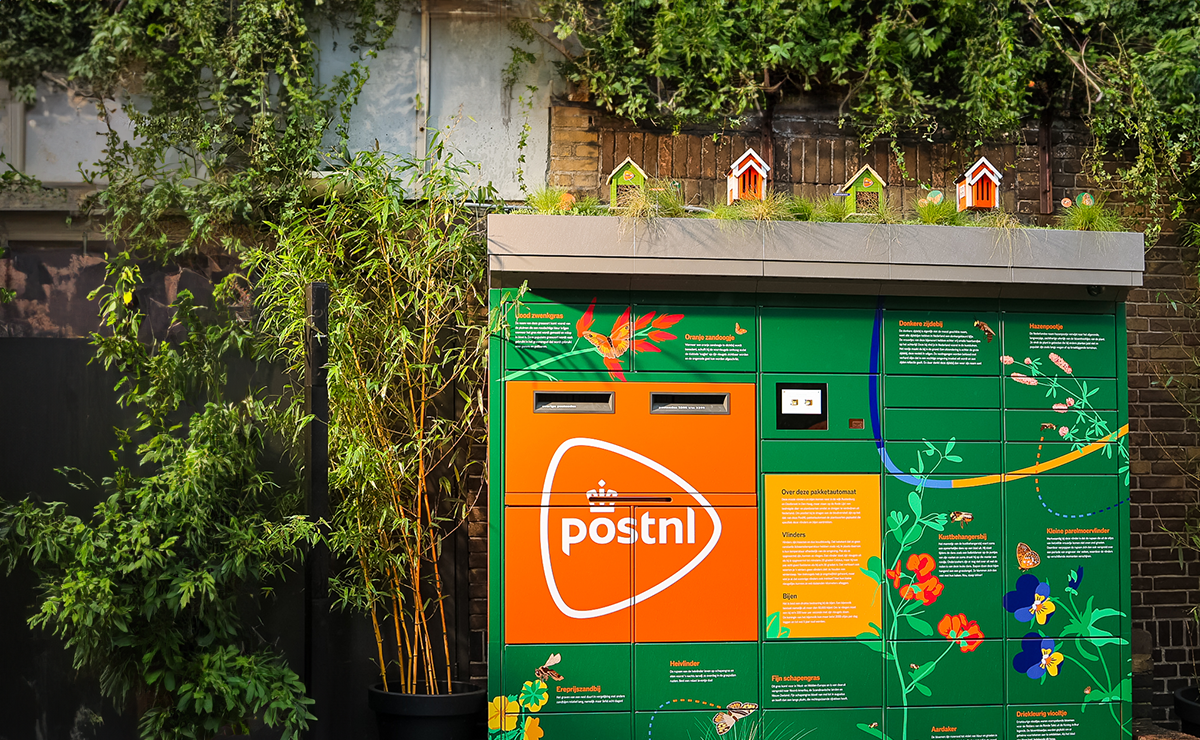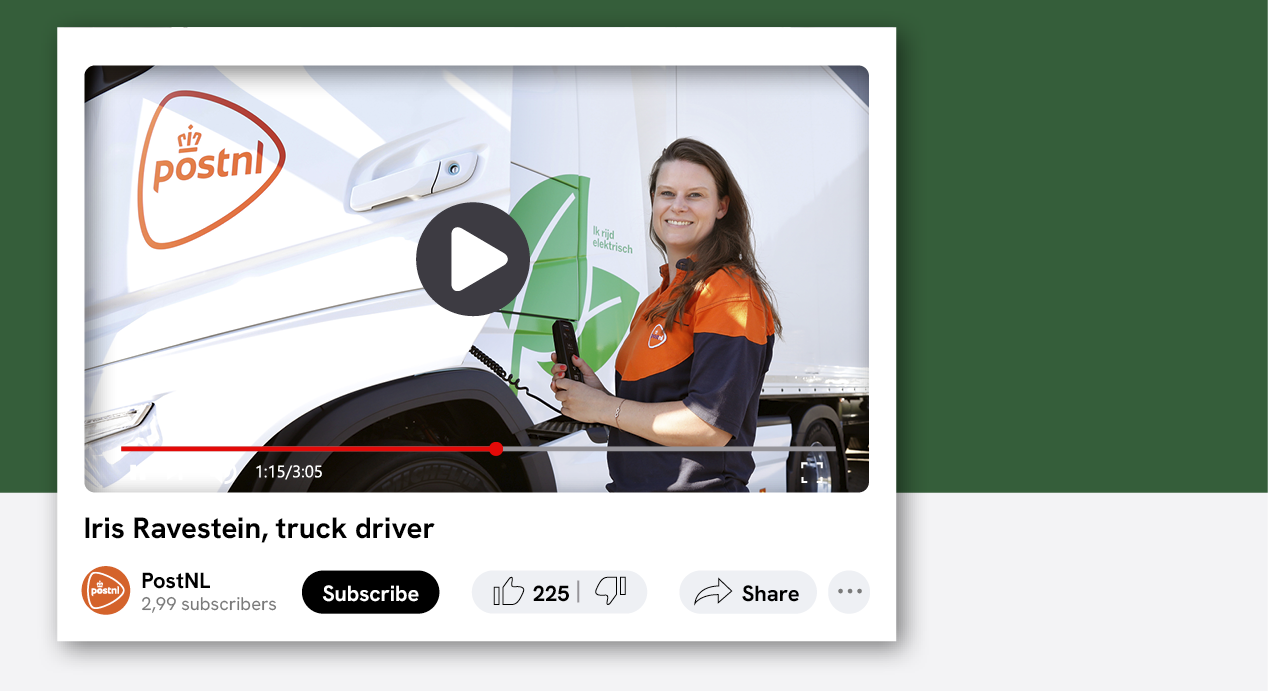Climate change
Ambitious goals demand clear, measurable targets. Which is why we have set concrete targets and timelines for our sustainability strategy, ensuring transparency and accountability, enabling us to monitor our progress closely. Our goal is to reduce 90% of our own carbon emissions in scope 1 and 2 and 45% of our outsourced scope 3 emissions by 2030. Looking further ahead, we are committed to achieving net-zero emissions by 2040. By then, we aim to have reduced all our carbon emissions by 90%, significantly minimising our impact on the climate.
Shifting to emission-free logistics plays a pivotal role in the environmental aspect of our sustainability strategy. As a key player in the logistics industry, we recognise that our operations significantly contribute to greenhouse gas (GHG) emissions. By accelerating the adoption of electric vehicles, e-bikes, and alternative delivery methods, we can drastically cut emissions, especially in urban areas. This not only reduces our carbon footprint but also contributes to healthier air quality, benefiting our employees, the customers we serve daily, and society in general. To help our customers track our progress, in 2024 we continued to communicate CO2e emissions data per parcel (319 grammes) and mail item (12 grammes) for deliveries, reflecting ‘well-to-wheel’ emissions, including large truck transport and delivery partners.
Maximising the use of renewable energy throughout our operations is equally important. From powering sorting centres with solar energy to implementing energy-efficient technologies in our facilities, our commitment to more sustainable energy reduces our dependency on fossil fuels and enhances the resilience of our operations in the face of rising energy costs and potential resource shortages.
Electrification of our fleet
By 2030, we aim to deliver emission-free from the final sorting centre to the consumer or an alternative pick-up location, which is why we currently have over 4,000 electric vehicles in our own fleet, from e-bikes to large trucks. To enhance the sustainability of our delivery services nationwide, during the year we rolled out e-vehicles across the following networks. We reached an important milestone in 2024 when we installed our 1,000th charging point across the company, and by year end had 1,180.
E-commerce
In 2024, we expanded our electric vehicle fleet with the addition of 276 e-vehicles across our e-commerce networks in the Netherlands and Belgium. This included electric vans, light electric freight vehicles, Stints, and our first large electric truck at our Nieuwegein location.
In addition to expanding our own fleet, we are actively encouraging our delivery partners to transition to emission-free vehicles. By the end of the year, a growing share of kilometres driven by delivery partners in the Netherlands and Belgium were emission-free, supporting our commitment to sustainable logistics.
First to drive an e-truck
Iris Ravestein has broken new ground at PostNL, becoming the first to drive an e-truck. After six years at an accounting firm, she obtained her HGV licence, seeking the freedom of the open road. “Office life wasn’t for me,” she says. “Being a truck driver offers variety—one moment I’m collecting parcels from customers, the next I’m travelling between sorting centres.”
Now, Iris is at the forefront of sustainable transport, testing PostNL’s new e-truck. “It’s very quiet and accelerates quickly,” she explains. “The towing capacity matches traditional trucks, but it produces no CO2 emissions. The main difference is its limited range, which requires carefully planned routes to return for charging.” Currently operating within Utrecht, Iris admits missing her usual cross-country drives but acknowledges the adjustment process. “It’s a learning curve for everyone—drivers, planners, and logistics teams,” she says. With her input, PostNL is working towards a more sustainable future.
Mail in the Netherlands
While we currently deliver letters and letterbox packages emission-free in the last-mile to 96% of residential addresses in the Netherlands, we continue to reduce emissions across our mail network. By the end of the year, we had added 55 e-vans to our mail fleet, bringing the total number of electric vehicles to 236. This initiative is projected to save approximately 444 tonnes of CO2e annually, compared to traditional diesel-powered vehicles. The year also marked a key milestone: the complete electrification of our scooter fleet. We now operate 591 three-wheel e-scooters and 473 two-wheel e-scooters, totaling over 1,000 electric scooters across our mail operations.
As a result of grid congestion challenges in the Netherlands, which limit our ability to install sufficient charging points at our own locations, we have partnered with external companies that have available capacity to provide off-site charging solutions. Currently, we operate off-site charging at three locations.
Use of alternative fuels
In 2024, we continued to utilise renewable HVO100 diesel across our operations, an interim solution that bridges the gap until the market is ready for battery-electric large trucks. HVO100 has been instrumental in reducing GHG emissions by up to 90% over its lifecycle compared to fossil diesel. We applied this sustainable fuel in both last-mile delivery and collection, as well as in the middle-mile operations.
While we optimised our budget allocation mid-year, leading to a more targeted use of HVO100 from July onwards in some areas, we maintained a strong focus on minimising emissions. This approach contributed to a CO2e emission of 219 grammes per kilometre for HVO100 transport, demonstrating our commitment to sustainability.
Additionally, on 22 April, Earth Day, PostNL and our international subsidiary Spring implemented an innovative solution to integrate HV0100 into Europe's diesel network, setting a new benchmark for sustainability in logistics. This approach enables us to purchase sufficient biofuel to cover the equivalent of all our international road transport in Europe, where HVO100 is not yet available, reducing our scope 3 emissions as effectively as if our trucks were running directly on HV0100. Since we cannot mandate our delivery partners to use renewable fuels, and availability remains limited in some regions, this solution provides a practical way to drive emissions reduction and demonstrates our commitment to making logistics more sustainable.
Investment in sustainable infrastructure
Sustainable innovations at new parcel sorting centre
In line with our strategic commitment to building a sustainable and future-proof logistics network, in 2024 we opened our 27th parcel sorting centre, in Alphen aan den Rijn. The new facility is a key addition to our growing network, enhancing our capacity to meet the increasing demand in the e-commerce sector.
This state-of-the-art sorting centre is among the most sustainable commercial buildings in the Netherlands. And like all 27 PostNL parcel sorting centres, it will be BREEAM-certified, with the highest standard for new construction, 'Outstanding', expected to be awarded in the second quarter of 2025. Every aspect of the building is designed to operate with minimal environmental impact.
It is fully equipped with LED lighting and features heat recovery systems. With 1,864 solar panels on the roof and the infrastructure in place to install charging stations, the building integrates sustainable solutions throughout. Additionally, a battery system stores locally generated energy during the day, ensuring a reliable and sustainable power source for our operations. This energy not only powers sorting machines but will in the near future also be used to charge electric vans during the evening and night. By doing so, we reduce our reliance on the grid during peak hours, contribute to a more stable energy supply, and support the transition to a cleaner, greener logistics network.
As part of the sustainability assessment, we conducted a comprehensive flora and fauna study to better understand the local ecosystem. Based on the findings, the area surrounding the building has been carefully designed to promote biodiversity. Nesting boxes have been installed to provide safe habitats for local bats, birds, and insects, addressing the specific needs of native species. In addition, a diverse range of trees, plants, and flowers known to support pollinators and other wildlife are being planted, creating a thriving green space. This initiative not only enriches the environment but also reinforces our commitment to fostering a healthy and sustainable ecosystem.
Water conservation and reuse
At our two newest parcel sorting centres in Hoogeveen and Alphen aan den Rijn, we also implemented a grey water system to enhance water conservation efforts. Rainwater is collected in dedicated basins, allowing us to reuse it for non-potable purposes such as flushing toilets. This approach significantly reduces the consumption of drinking water at these sites.
Local ecosystems
While we recognise that our direct impact on biodiversity is limited, we remain committed to minimising any potential effects. In line with this commitment, we consistently take proactive measures in our operations to support local ecosystems. For example, when constructing or renovating our sorting centres, we engage independent experts to conduct comprehensive flora and fauna assessments, ensuring that we adopt all necessary steps to protect and preserve local biodiversity. This has included introducing native plant species around our facilities, reducing the need for irrigation by promoting vegetation suited to hot and dry conditions, reliant on local rainfall. Additionally, we have installed nesting boxes for various bird species and shelters for bats, fostering local wildlife and contributing to natural habitat creation. These actions underscore our ongoing efforts to work in harmony with nature and reflect our long-term commitment to environmental stewardship.

Network efficiency
Optimising our operations remains central to our strategy for enhancing efficiency and reducing GHG emissions. As well as lowering costs and enhancing customer convenience, improving network efficiency can also contribute to our sustainability agenda. In 2024, there were two notable developments within this area:
- Expanded delivery options at APLs and our retail network: This reduces the need for last-mile deliveries to home addresses, thus cutting emissions from customer transport
- Discontinuation of Sunday deliveries: Streamlining operations by removing less efficient delivery routes associated with low parcel volumes helps cut our overall emissions.


